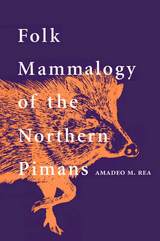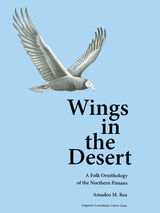2 books about Northern Pimans

Folk Mammalogy of the Northern Pimans
Amadeo M. Rea
University of Arizona Press, 1998
Knowledge held about animals by Pima-speaking Native Americans of Arizona and northwest Mexico is intimately entwined with their way of life—a way that is fading from memory as beavers and wolves vanish also from the Southwest. Ethnobiologist Amadeo Rea has conducted extensive fieldwork among the Northern Pimans and here shares what these people know about mammals and how mammals affect their lives.
Rea describes the relationship of the River Pima, Tohono O'odham (Papago), Pima Bajo, and Mountain Pima to the furred creatures of their environment: how they are named and classified, hunted, prepared for consumption, and incorporated into myth. He also identifies associations between mammals and Piman notions of illness by establishing correlations between the geographical distribution of mammals and ideas regarding which animals do or do not cause staying sickness. This information reveals how historical and ecological factors can directly influence the belief systems of a people. At the heart of the book are detailed species accounts that relate Piman knowledge of the bats, rabbits, rodents, carnivores, and hoofed mammals in their world, encompassing creatures ranging from deer mouse to mule deer, cottontail to cougar.
Rea has been careful to emphasize folk knowledge in these accounts by letting the Pimans tell their own stories about mammals, as related in transcribed conversations. This wide-reaching study encompasses an area from the Rio Yaqui to the Gila River and the Gulf of California to the Sierra Madre Occidental and incorporates knowledge that goes back three centuries. Folk Mammalogy of the Northern Pimans preserves that knowledge for scholars and Pimans alike and invites all interested readers to see natural history through another people's eyes.
Rea describes the relationship of the River Pima, Tohono O'odham (Papago), Pima Bajo, and Mountain Pima to the furred creatures of their environment: how they are named and classified, hunted, prepared for consumption, and incorporated into myth. He also identifies associations between mammals and Piman notions of illness by establishing correlations between the geographical distribution of mammals and ideas regarding which animals do or do not cause staying sickness. This information reveals how historical and ecological factors can directly influence the belief systems of a people. At the heart of the book are detailed species accounts that relate Piman knowledge of the bats, rabbits, rodents, carnivores, and hoofed mammals in their world, encompassing creatures ranging from deer mouse to mule deer, cottontail to cougar.
Rea has been careful to emphasize folk knowledge in these accounts by letting the Pimans tell their own stories about mammals, as related in transcribed conversations. This wide-reaching study encompasses an area from the Rio Yaqui to the Gila River and the Gulf of California to the Sierra Madre Occidental and incorporates knowledge that goes back three centuries. Folk Mammalogy of the Northern Pimans preserves that knowledge for scholars and Pimans alike and invites all interested readers to see natural history through another people's eyes.
[more]

Wings in the Desert
A Folk Ornithology of the Northern Pimans
Amadeo M. Rea
University of Arizona Press, 2008
There is a common but often unspoken arrogance on the part of outside observers that folk science and traditional knowledge—the type developed by Native communities and tribal groups—is inferior to the “formal science” practiced by Westerners. In this lucidly written and humanistic account of the O’odham tribes of Arizona and Northwest Mexico, ethnobiologist Amadeo M. Rea exposes the limitations of this assumption by exploring the rich ornithology that these tribes have generated about the birds that are native to their region. He shows how these peoples’ observational knowledge provides insights into the behaviors, mating habits, migratory patterns, and distribution of local bird species, and he uncovers the various ways that this knowledge is incorporated into the communities’ traditions and esoteric belief systems. Drawing on more than four decades of field and textual research along with hundreds of interviews with tribe members, Rea identifies how birds are incorporated, both symbolically and practically, into Piman legends, songs, art, religion, and ceremonies. Through highly detailed descriptions and accounts loaded with Native voice, this book is the definitive study of folk ornithology. It also provides valuable data for scholars of linguistics and North American Native studies, and it makes a significant contribution to our understanding of how humans make sense of their world. It will be of interest to historians of science, anthropologists, and scholars of indigenous cultures and folk taxonomy.
[more]
READERS
Browse our collection.
PUBLISHERS
See BiblioVault's publisher services.
STUDENT SERVICES
Files for college accessibility offices.
UChicago Accessibility Resources
home | accessibility | search | about | contact us
BiblioVault ® 2001 - 2024
The University of Chicago Press









